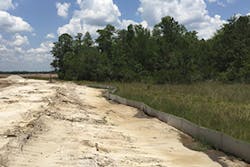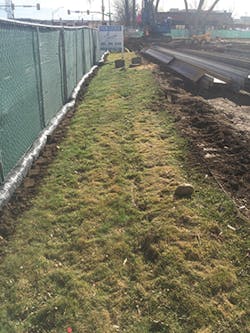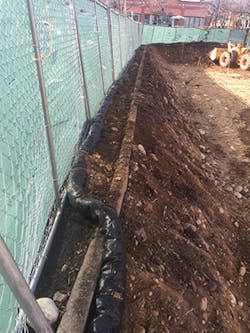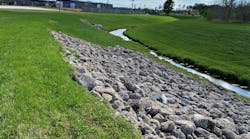Work on the average construction site disrupts many cubic yards of dirt. All of that disrupted soil poses a big sediment control challenge. Given the unpredictability of storms and rainfall, controlling sediment requires vigilance. It also adds to the cost of construction projects. But if sedimentation is not controlled, the cost is even higher: potential fines from state and federal regulatory agencies and damage to the environment.
Fortunately there are some very effective strategies and products to help manage sediment on construction sites. Containment
—a classic military strategy—is the first line of defense for sediment control on construction projects.
One of the most common ways to do containment is by installing an effective control all around the perimeter of the site. A silt fence or a similar, but improved, product will hold soil and sediment on the inside of the perimeter, but allow runoff to flow through.
Three companies doing erosion control work on projects in Florida, Utah, and Missouri follow that strategy. Here are the stories behind some of their interesting projects.
Bexley Ranch
“We’re passionate about the outdoors and protecting the natural environment,” says Grayson McCormick, environmental compliance supervisor for RIPA & Associates, the largest construction firm in Tampa, FL, with 650 employees.
McCormick leads RIPA’s Environmental Division. In the last 12 years it has grown from six to 30 employees.
“I take a lot of pride in the fact that RIPA is without a doubt a leader in environmental compliance. We spend millions on environmental compliance. We do it because it’s the right thing to do,” he explains.
With 81 active job sites, RIPA’s Environmental Division has three crews that “do nothing but repair and maintain silt fences,” says McCormick. “I’d say that about 70 of those jobs have Silt-Saver products on them.”
One of those jobs is the Bexley Ranch project near Tampa. The thousands of acres of land had been held by several generations of the Bexley family since the late 1940s.
Because the area is environmentally sensitive, it took years before the Florida Department of Environmental Protection and other agencies granted the required permits to allow development. A condition for development was the preservation of part of the land as a natural habitat for wildlife.
It will take 10 years or more to develop this master-planned community. The land sits at the headwaters of the Anclote River, where the water is pristine and wetlands abound, requiring extra effort to protect the environment.
“The quality of the wetlands is great. It’s totally undisturbed land. The most unpolluted water in the entire river is here, at its source,” says McCormick.
The Bexley Ranch development will be done in sections. RIPA began clearing the first section of the land—a bit more than 300 acres—in October 2015.
“Perimeter control protecting the wetlands from runoff from the job site is critical. We’ve got 70,000 linear-feet of silt fence for perimeter control. Of that, a solid 75% is adjacent to wetlands. Everywhere you look there is surface water and wetlands,” says McCormick.
“On our job sites, to be in compliance you have to use products that are better than the industry standards,” he explains.
McCormick and his hard-working crewmembers rely on Belted Silt Retention Fence (BSRF) from Silt-Saver of Conyers, GA. “It costs three or four times what regular silt fence costs. Some of it costs 10 times as much, but it’s worth it,” he notes. “With the conditions we work in, as sensitive as these areas are, we don’t have a lot of room for error.”
Developing the Bexley Ranch land is “basically developing a floodplain,” he says. “In summer, 75% of what we’re developing would be knee-deep in water, so a lot of fill has to be added, and there’s a lot of rerouting of surface water.
“Ten feet on the other side of the silt fence is water and cypress trees. A lot of the land is under the Army Corps of Engineers’ jurisdiction. Runoff from it flows right into the river, not into a tributary or a ditch. That’s a big deal,” he notes.
Adding to the challenge of working in the sensitive wetlands of Bexley Ranch is Tampa’s weather. McCormick says this part of Florida is one of the rainiest.
“We average 67 inches of rain per year, so stormwater is a big deal for us. In summer, we get one inch of rain almost every afternoon, the most intense type of rain. That’s 30 acres of sheet flow coming at the Silt-Saver fence.”
He adds, “One row of BSRF is worth three rows of regular-grade DOT silt fence. I’ve seen it have dirt to the top—two or three feet of dirt—and still hold it [during a heavy rain]. Even with a double row of regular silt fence, you’d have dirt going over the top and 50 feet into the wetlands.”
Bexley Ranch in Tampa, FL
McCormick terms Silt-Saver’s BSRF “a superior product. If it works with what we do, it’ll work for anybody.”
Finding a product that works under challenging weather and environmentally sensitive conditions makes good business sense. If sediment and dirt pollute pristine waters, like those in the Anclote River’s headwaters, he says, “you can rack up 50, 60, 100,000 dollars’ worth of fines. If a job site is shut down, that’s millions the company would lose.”
If there were a break in the construction site’s perimeter that sends sediment into the river, RIPA & Associates would be required to clean it up at its own expense. The cost would be quite high.
“We couldn’t use machinery. We’d have to have 20 guys with wheelbarrows and shovels. Using the BSRF pays for itself very quickly,” he says.
Despite the challenges of sudden heavy rainstorms on an almost daily basis and working in a highly sensitive environment that has so much surface and groundwater, McCormick believes his team will succeed on this unique project. The basis for his confidence is their experience coupled with the water management plan.
“Having an effective water management plan for your construction site is absolutely critical to the success of the job, not just for environmental compliance, but in getting the work done on time, and on budget,” he says. “And water is your number one enemy if you’re building on dirt—surface water from storms and groundwater coming out when you excavate.”
In practical terms, “a water management plan saves money. With one, we build the job faster and make more money because we get through sooner,” he notes.
“Before we start a job, we deal with all of the water on the site. We put in all the pipes and culverts to manage the water, so we can do the work and we’re not creating pollution,” explains McCormick.
As for environmental compliance on water-quality issues, McCormick says, “If you have a water management plan and have a sequence [for the work], nine times out of 10, the inspectors will say ‘OK.'”
He cautions, “You have to minimize the environmental impact as much as possible, but there is no way for nothing to ever go wrong.”
If something does go wrong, RIPA’s policy is to “do something better the next time. You have to elevate that BMP, as the general construction permit says.”
Inspectors are a strong presence on such a sensitive site as the Bexley Ranch development. McCormick says they’re from the city of Tampa, Pasco County (“It has jurisdiction there and a strict stormwater policy”), the Florida Department of Environmental Protection, the Army Corps of Engineers, and the Southwest Florida Water Management District.
“We see them very regularly. Every other week or so some regulator is here, or I get a phone call,” he says. Two full-time company inspectors check the site’s perimeter “after every half-inch of rainfall, per our permit.”
Keeping a Low Profile in Boulder
Paul Gillespie is chief of operations and quality assurance at Silver Leaf SWPPP in Linden, UT. The firm does erosion control and stormwater work on various types of commercial projects.
In April of this year, Gillespie and the Silver Leaf SWPPP crew performed sediment control work on a project at the Marriott Hotel in Boulder, CO. The project involved the extension of an existing parking lot.
To keep sediment within the boundary of the construction site, the Silver Leaf SWPPP crew installed Extreme sediment control wattles from Gator Guard of Boise, ID. Gator Guard also makes a regular sediment wattle. The lightweight black wattles measure 6 inches in diameter, come in 25-foot lengths, and are reusable.
“Marriott takes a lot of pride in their properties,” says Gillespie. “Gator Guard is a low-profile product. It doesn’t show as much. It’s a little less visible, as far as what the public see, but it does a real good job.”
On the Marriott project, “we installed the Gator Guard right along the existing parking lot. There’s a corner, and trucks would drive on top of it, but it can take some abuse and bounce back. If a silt fence is damaged, it looks bad,” he notes. “The whole installation was 1,200 linear-feet. About 500 to 600 feet of that was visible.”
He says the Gator Guard wattles are easy to install. “The Extreme wattles come with a splash apron about nine inches flat. They supply pins that you hammer into the ground and then put dirt on top to weigh it down. The water filters through slowly,” explains Gillespie.
Not only is Gator Guard easy to install, “you don’t have to have a ton of equipment. Installing the 1,200 feet at the Marriott took two guys about seven to eight hours,” he says.
Gillespie notes that Gator Guard “has a high UV rating. It won’t deteriorate in the sun. We do a lot of work in Salt Lake City and Provo, and we do maintenance on Gator Guard [after installation]. If trucks run over Gator Guard, it still works.”
Gillespie says that Gator Guard, even though it is more expensive than a basic silt fence, is economical. “It’s reusable. Some companies pull it and have us to reinstall it on another site. It’s a really tough product. It won’t tear. We’ve used the same Gator Guard on up to three jobs before it gets beaten up.”
The site of the Marriott in Boulder, CO
The biggest challenge on the Marriott job in Boulder, he says, was “coordinating with the contractor for the job site to be prepared when we got there. Ideally, we want to install the Gator Guard on dirt so there is dirt to back fill it. Making sure a site is prepared by the contractor—or that we have the capability to prepare it first, bringing our own machines or renting them—is essential.”
The weather in Boulder the day the Extreme wattles were installed was good, with no rain or snow. “But the next day it snowed a ton,” recalls Gillespie, adding that the Gator Guard “can take some weather damage.”
The work at the Marriott was on flat land, but Gillespie notes, “If you have a slope, Gator Guard will slow down the flow. It’s just a good product.”
He adds, “We have big storms here. The water comes down quickly, and excess water goes over the top and sediment stays inside. But sediment builds up with a silt fence, and the fence can get damaged by the weight of the water.”
His company uses silt fences where the customers want them. “If a silt fence is installed and maintained right, it will hold up, but if it’s damaged or gets holes, the sediment will get through.”
To protect stormwater inlets during the Marriott parking lot job, Silver Leaf SWPPP used Dandy Bags made by Dandy Products of Powell, OH.
“You put the metal grate inside the bag. It collects sediment on top, and you just sweep it off with a broom. With some other products, you have to pull the bags out and clean them. That’s more expense, with extra labor charges.”
Gillespie and his crew relied on Gator Guard Extreme wattles again for sediment control on a construction project at the University Mall in Orem, UT.
“The shopping mall has an existing asphalt parking lot. The construction company needed dirt to stay on this site while they were doing an addition to the mall,” explains Gillespie. “We created a controlled area, a big square about 400 by 400 feet with Gator Guard all around it,” he says. “It took three or four men about a day” to fill the area.
Reflecting on the work, Gillespie says, “One of the biggest challenges is keeping dirt on asphalt, because water with dirt on asphalt creates a fast, slick surface.”
The installation was done in August 2015. Construction is still ongoing, but “no dirt has gotten beyond” the Gator Guard perimeter.
Gillespie says he is seeing more regulation for erosion and sediment control on construction projects. “The contractor is regulated by the city that is regulated by the state, then there is regulation at the national level, from EPA. It falls on the contractor to see that their site is compliant.”
He adds, “Over the last five years, it’s gone from very little regulation to every job site being required to have stormwater permitting and inspection every other week. The regulations have been getting a lot tighter, and from now on, as people become more aware of clean water, it’s going to be [even] more regulated.”
Products that erosion control companies install “need to be EPA-certified. Gator Guard is approved, so that’s another reason to use it.”
All of this increasing regulation has brought Silver Leaf SWPPP more business, as the company fills a new niche. “Every year there are more and more policies [to comply with]. There is a lot of paperwork as far as getting stormwater permits.”
He adds, “Contractors already have so much to deal with, we’ve tried to come in and eliminate the headache for them, to take care of their stormwater stuff.”
That means that Silver Leaf SWPPP will “take care of everything involved. We will file all of their paperwork with the city and the state. We install erosion control measures, we offer inspection, and we also do maintenance.”
The Yard Guys
Shelby Miller and his partner brother got into business planting lawns for new residential construction, but then switched to erosion control work. Their firm, The Yard Guys, is in Springfield, MO.
Erosion control work appealed to them because “it needs to be done right. It really does matter how it’s done. We make sure it’s effective. Gary and Tom [Baker and Truelsen, makers of E-Tube filter socks] have the same philosophy,” says Miller.
The site of the Marriott
in Boulder, CO
“We do a lot of highway and commercial construction work, but one of our residential projects was very challenging,” he says.
East of Springfield, a 15,000-square-foot house is slowly being built on 4.5 acres. The setting is unusual because the house is situated at the bottom of a hill, in a valley. About 400 yards from the construction site sits an old farmhouse, near a creek. The site has poor drainage. When the soil was disrupted for the new construction, mud flowed around the farmhouse and into the creek. Its owner was very unhappy.
In such a rural area, there were few inspections, but the owners of the big new house under construction wanted to do the right thing, and correct the problem they had inadvertently created.
Miller and crew were called in to solve the problem. “The new property owners were going way above and beyond what was required,” he says.
Miller chose to use filter socks from E-Tube of Grimes, IA. (The company is also kown as Soil-tek.)
A dam and spillway were added to stop erosion on the hillside. Grass has grown in. Miller checks on the site every three or four months, but before the grass was established on the hill, he inspected the site after every two big rainfalls.
“There’s been no sediment; only clear water flows down into the creek,” says Miller.
It took four people between two and three hours to install the biodegradable tubes on the project in early summer 2015. The weather was dry, but it rained a lot—6 inches in a few hours—not long after the installation was done.
“I was impressed with how well the filter socks were working,” says Miller.
Miller also used Curlex, an erosion control blanket made of aspen, from American Excelsior. “It works well—doesn’t tangle. It’s a great way to disperse rainwater. We combined it with seeding—80% fescue and 20% rye—and then hydroseeded more seed with fertilizer and tackifier.”
The main challenge with the installation was “the way the land lay and how it got water from all angles. We had to figure out how the water would flow from three sides, about 220 degrees.”
Later, even though it wasn’t required, “We brought the city [of Springfield] inspector out to see what we had done, and he was impressed.”
Miller has come to prefer the E-Tube filter sock to silt fence. “It just works far better than a silt fence. It’s cheaper to install filter sock. A silt fence is higher in cost and requires more labor, plus machines for trenching. It’s messier and more damaging to the earth.
“In the last year or year and a half, we’re finding that a lot of places will let you substitute filter socks for silt fence. The installation is cheaper and the longevity is better,” says Miller.
He has found that repair and maintenance is also easier. “With a silt fence, it’s a big task to replace even a few feet. We use a two- by two- by 30-inch oak stake for the filter sock, and it doesn’t roll.”
Miller buys the material from E-Tube and his employees fill the socks, as they are needed for projects. It used to require a crew of five to fill the socks onsite, assembling them on a trailer. Now only two workers are needed, because the work is done before the crew leaves for the job site. “We make it all on pallets and take it with us on a skid steer or wheel loader. We don’t have to take a dozer or disturb the woods. It’s so much easier,” he says.
The fill material is “a shredded mulch screen-sized the way we need, with enough fines to catch stuff but still let water flow through. There’s no trash in it—no livestock bedding—just organic material,” explains Miller.
These three companies completed three very different erosion control projects. They are all committed to doing their best work to protect the environment, starting with secure perimeters.









